Active Chemical Sampling Using Jet Discharge Inspired by Crayfish: CFD Simulations of the Flow Fields Generated by the Jet Discharge Device †
Abstract
1. Introduction
2. Materials and Methods
2.1. Jet Discharge Device and Experimental Setup
2.2. Details of Simulations
2.3. Velocity Plofiles in Round Jet
3. Results
3.1. Simulation Results
3.2. Comparison with Experimental Results
4. Conclusions
Author Contributions
Funding
Acknowledgments
Conflicts of Interest
References
- Wall, C.; Perry, J.N. Range of action of moth sex-attractant sources. Entmol. Exp. Appl. 1987, 44, 5–14. [Google Scholar] [CrossRef]
- Grasso, F.W.; Basil, J.A. How lobsters, crayfishes, and crabs locate sources of odor: Current perspectives and future directions. Curr. Opin. Neurobiol. 2002, 12, 721–727. [Google Scholar] [CrossRef]
- Ishida, H.; Wada, Y.; Matsukura, H. Chemical sensing in robotic applications: A review. IEEE Sensors J. 2012, 12, 3163–3173. [Google Scholar] [CrossRef]
- Furton, K.G.; Myers, L.J. The scientific foundation and efficacy of the use of canines as chemical detectors for explosives. Talanta 2001, 54, 487–500. [Google Scholar] [CrossRef]
- Settles, G.S. Sniffers: Fluid-dynamic sampling for olfactory trace detection in nature and homeland Security—The 2004 Freeman Scholar Lecture. J. Fluids Eng. 2005, 127, 189–218. [Google Scholar] [CrossRef]
- Settles, G.S.; Kester, D.A.; Dodson-Dreibelbis, L.J. The external aerodynamics of canine olfaction. In Sensors and Sensing in Biology and Engineering; Barth, F.G., Humphrey, J.A.C., Secomb, T.W., Eds.; Springer: Vienna, Austria, 2003; pp. 323–355. ISBN 9783709160251. [Google Scholar]
- Goldman, J.A.; Koehl, M.A.R. Fluid dynamic design of lobster olfactory organs: High speed kinematic analysis of antennule flicking by Panulirus argus. Chem. Senses 2001, 26, 385–398. [Google Scholar] [CrossRef][Green Version]
- Breithaupt, T. Fan organs of crayfish enhance chemical information flow. Biol. Bull. 2001, 200, 150–154. [Google Scholar] [CrossRef] [PubMed]
- Dusenbery, D.B. Sensory Ecology: How Organisms Acquire and Respond to Information; W. H. Freeman: New York, NY, USA, 1992; ISBN 9780716723332. [Google Scholar]
- Grasso, F.W.; Consi, T.R.; Mountain, D.C.; Atema, J. Biomimetic robot lobster performs chemo-orientation in turbulence using a pair of spatially separated sensors: Progress and challenges. Robot. Auton. Syst. 2000, 30, 115–131. [Google Scholar] [CrossRef]
- Li, W.; Farrell, J.A.; Pang, S.; Arrieta, R.M. Moth-inspired chemical plume tracing on an autonomous underwater vehicle. IEEE Trans. Robot. 2006, 22, 292–307. [Google Scholar] [CrossRef]
- Provin, C.; Fukuba, T.; Okamura, K.; Fujii, T. An integrated microfluidic system for manganese anomaly detection based on chemiluminescence: Description and practical use to discover hydrothermal plumes near the Okinawa Trough. IEEE J. Ocean. Eng. 2013, 38, 178–185. [Google Scholar] [CrossRef]
- Denissenko, P.; Lukaschuk, S.; Breithaupt, T. The flow generated by an active olfactory system of the red swamp crayfish. J. Exp. Biol. 2007, 210, 4083–4091. [Google Scholar] [CrossRef] [PubMed]
- Takemura, R.; Takahashi, K.; Makishita, T.; Ishida, H. Adaptive chemical sampling device inspired by crayfish. ECS Trans. 2012, 50, 259–266. [Google Scholar] [CrossRef]
- Lee, H.W.; Chu, V.H. Turbulent Jets and Plumes: A Lagrangian Approach; Springer: New York, NY, USA, 2003; ISBN 9781402075209. [Google Scholar]
- Dewan, A.; Dutta, R.; Srinivasan, B. Recent trends in computation of turbulent jet impingement heat transfer. Heat Transf. Eng. 2011, 33, 447–460. [Google Scholar] [CrossRef]
- Hunt, G.R.; Ingham, D.B. Long range exhaustion—A mathematical model for the axisymmetric air flow of a local exhaust ventilation hood assisted by a turbulent radial jet. Ann. Occup. Hyg. 1996, 40, 171–196. [Google Scholar] [CrossRef]
- Motchkine, V.S.; Krasnobaev, L.Y.; Bunker, S.N. Cyclone Sampling Nozzle for an Ion Mobility Spectrometer. U.S. Patent App. US2003/0155506A1, 1 March 2005. [Google Scholar]
- Sasaki, I.; Janata, J.; Glezer, A. Fast gas sensing using an integrated synthetic jet actuator. IEEE Sens. J. 2006, 6, 1728–1733. [Google Scholar] [CrossRef]
- Ishida, H.; Mitsuishi, T.; Takemura, R.; Matsukura, H.; Ishida, H. Chemical sampling device for underwater robot: Jet discharge mimicking crayfish. In Proceedings of the ISOCS/IEEE International Symposium on Olfaction and Electronic Nose, Montreal, QC, Canada, 28–31 May 2017; pp. 116–118. [Google Scholar] [CrossRef]
- Ishida, H.; Mitsuishi, T.; Matsukura, H.; Ishida, H. Investigation of water sampling assisted by jets for active chemical sensing system. In Proceedings of the 17th International Meeting on Chemical Sensors, Vienna, Austria, 15–19 July 2018; pp. 641–642. [Google Scholar] [CrossRef]
- Ferziger, J.H.; Perić, M. Computational Methods for Fluid Dynamics, 3rd ed.; Springer: Berlin, Germany, 2002; ISBN 9783540420743. [Google Scholar]
- Ghahremanian, S.; Moshfegh, B. Evaluation of RANS models in predicting low Reynolds, free, turbulent round jet. J. Fluids Eng. 2014, 136. [Google Scholar] [CrossRef]
- Shih, T.-H.; Liou, W.W.; Shabbir, A.; Yang, Z.; Zhu, J. A new k-ε eddy viscosity model for high Reynolds number turbulent flows. Comput. Fluids 1995, 24, 227–238. [Google Scholar] [CrossRef]
- Xu, G.; Antonia, R.A. Effect of different initial conditions on a turbulent round free jet. Exp. Fluids 2002, 33, 677–683. [Google Scholar] [CrossRef]
- Kwon, S.J.; Seo, I.W. Reynolds number effects on the behavior of a non-buoyant round jet. Exp. Fluids 2005, 38, 801–812. [Google Scholar] [CrossRef]
- Vouros, A.P.; Panidis, T. Turbulent properties of a low Reynolds number, axisymmetric, pipe jet. Exp. Therm. Fluid Sci. 2013, 44, 42–50. [Google Scholar] [CrossRef]
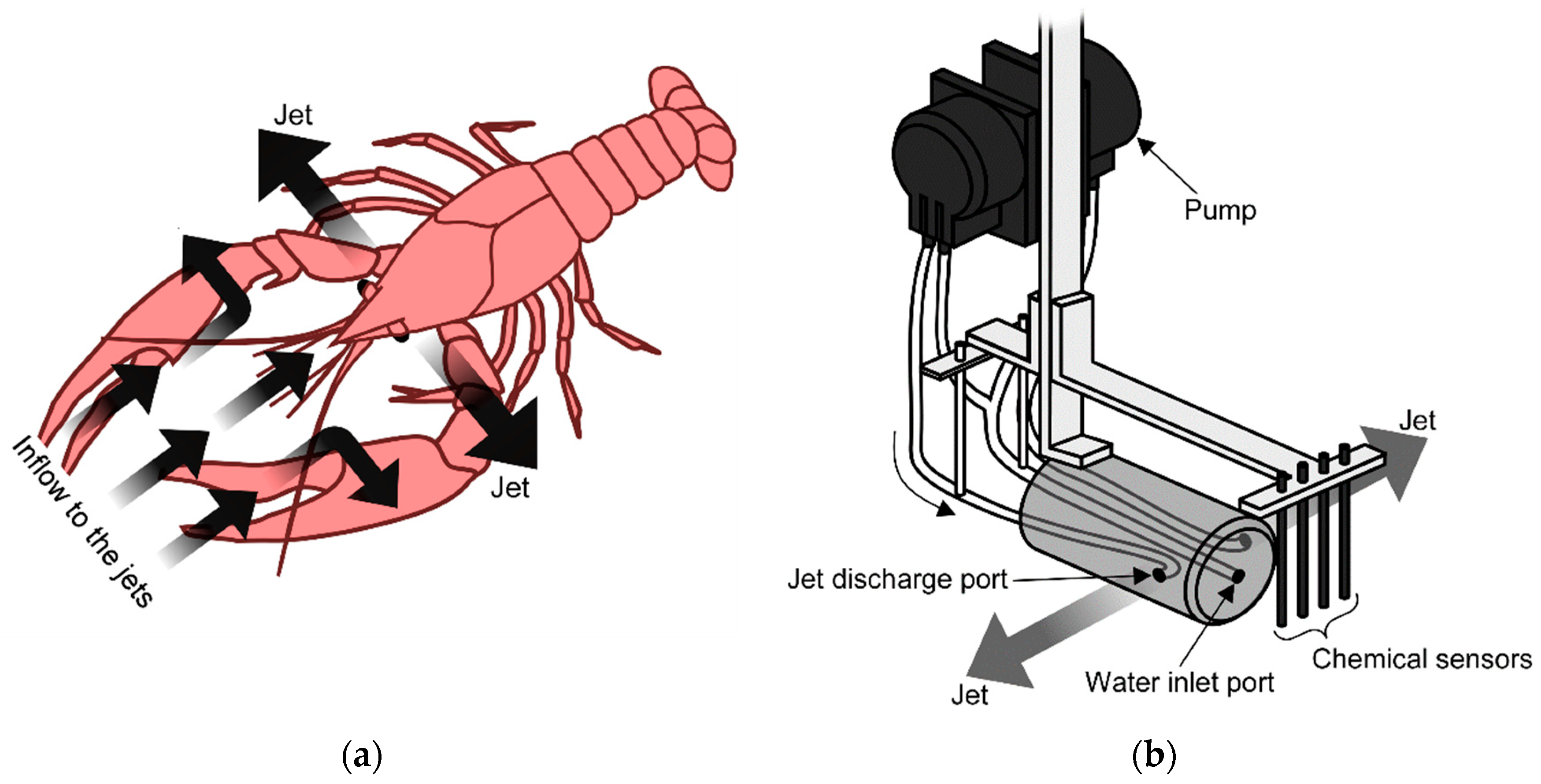


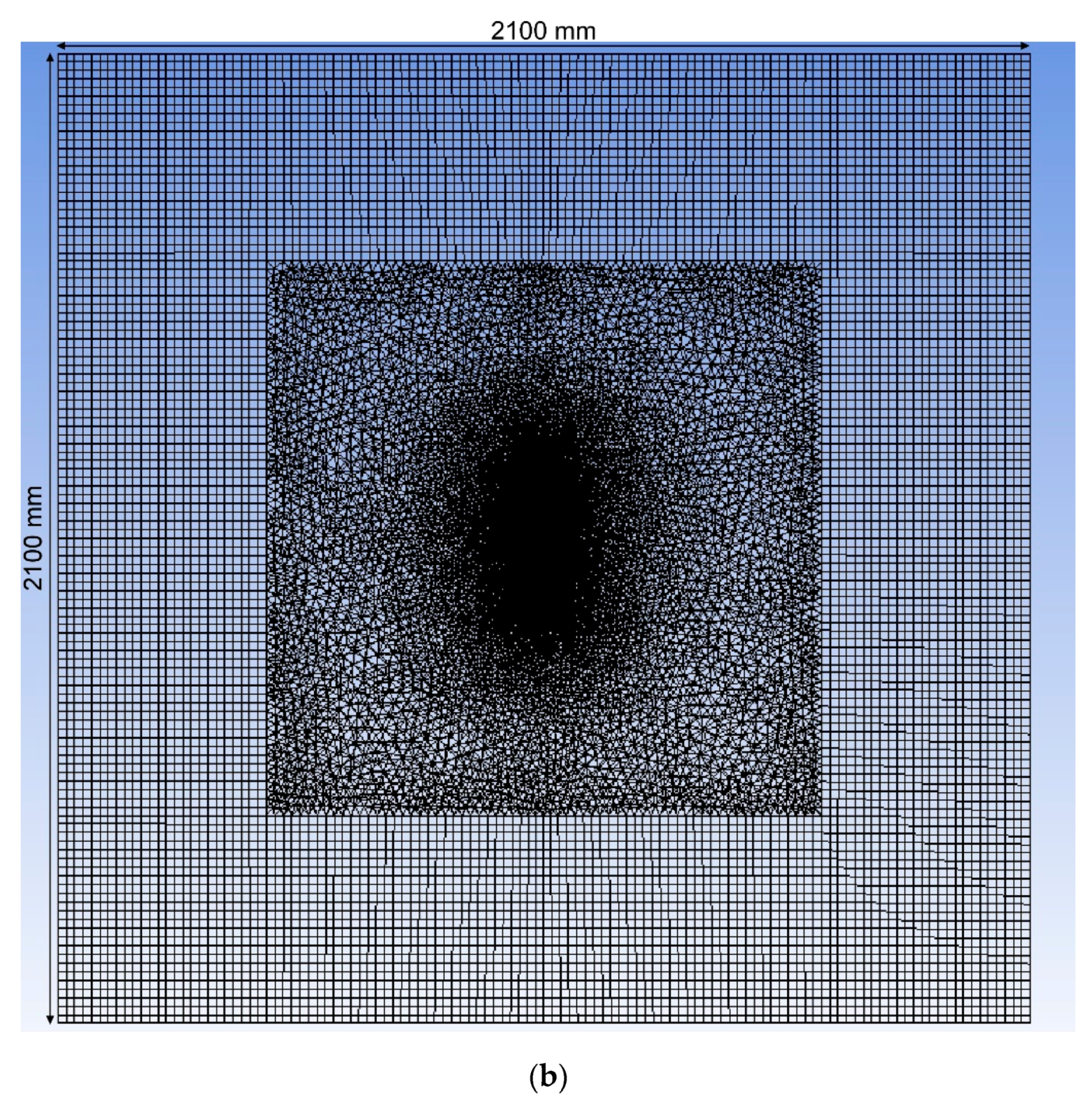



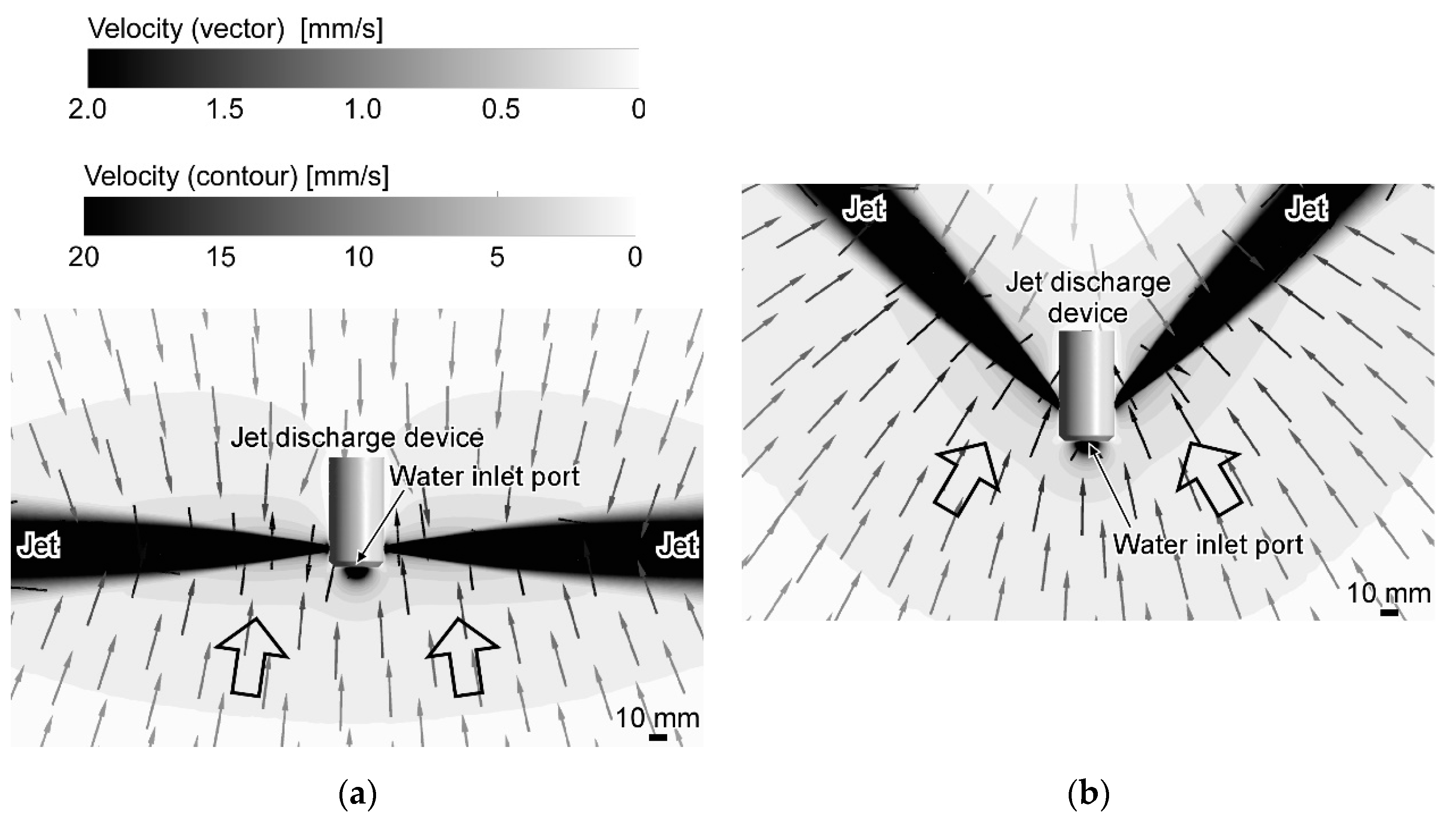

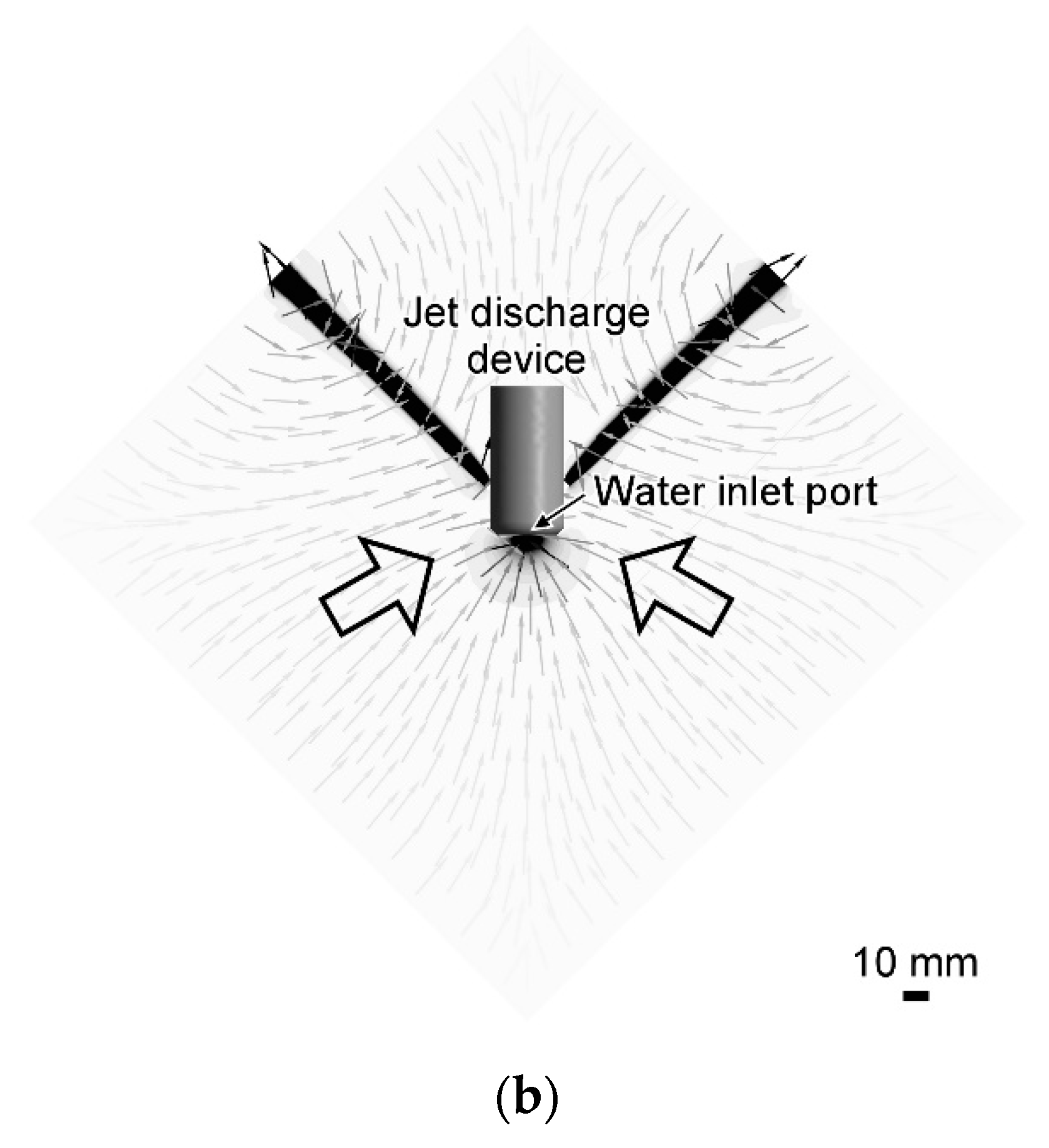



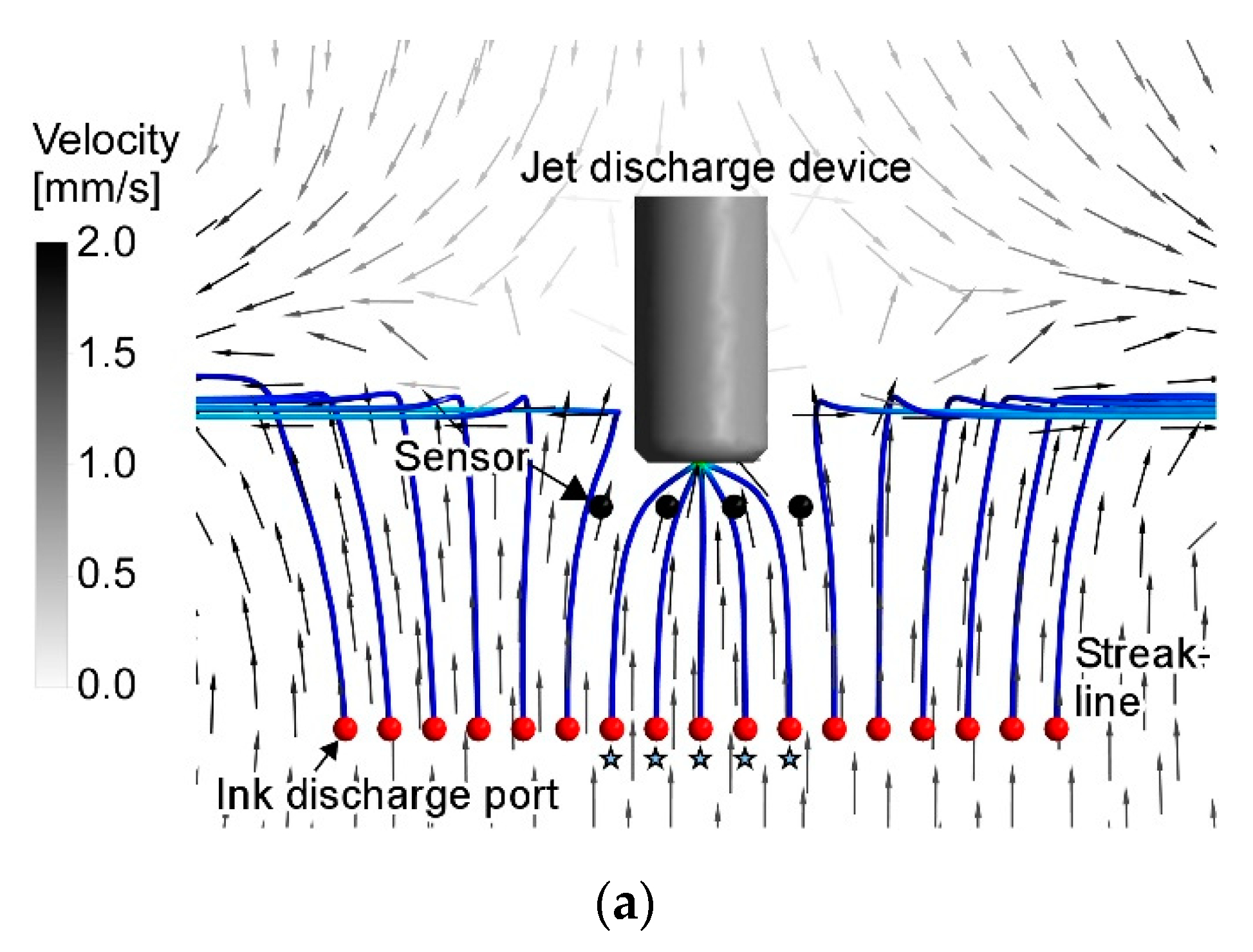
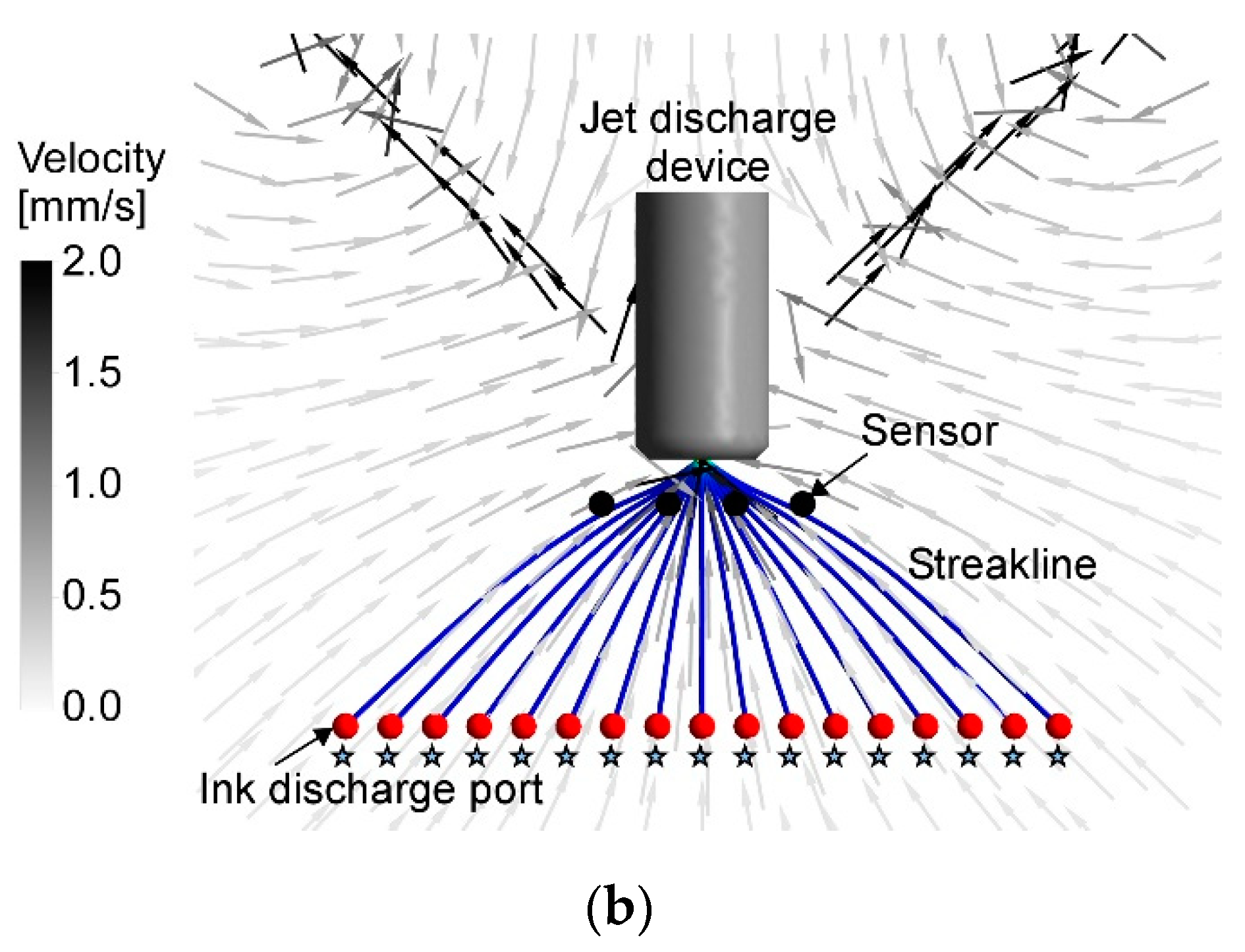


| Jet Discharge to the Sides | Jet Discharge to 45° Backward | |
|---|---|---|
| Computational domain | 568 mm in width, 284 mm in depth, and 100 mm in height | 284 mm in width, 284 mm in depth, and 100 mm in height |
| Total number of cells | 786,298 (Growth rate = 1.16250) | 940,068 (Growth rate = 1.16250) |
| Jet Discharge to the Sides | Jet Discharge to 45° Backward | |
|---|---|---|
| Computational domain | 2100 mm in width, 2100 mm in depth, and 100 mm in height | 2100 mm in width, 2100 mm in depth, and 100 mm in height |
| Total number of cells | 11,247,418 (Growth rate = 1.06) | 8,022,878 (Growth rate = 1.06) |
© 2020 by the authors. Licensee MDPI, Basel, Switzerland. This article is an open access article distributed under the terms and conditions of the Creative Commons Attribution (CC BY) license (http://creativecommons.org/licenses/by/4.0/).
Share and Cite
Ishida, H.; Takemura, R.; Mitsuishi, T.; Matsukura, H.; Ishida, H. Active Chemical Sampling Using Jet Discharge Inspired by Crayfish: CFD Simulations of the Flow Fields Generated by the Jet Discharge Device. Sensors 2020, 20, 522. https://doi.org/10.3390/s20020522
Ishida H, Takemura R, Mitsuishi T, Matsukura H, Ishida H. Active Chemical Sampling Using Jet Discharge Inspired by Crayfish: CFD Simulations of the Flow Fields Generated by the Jet Discharge Device. Sensors. 2020; 20(2):522. https://doi.org/10.3390/s20020522
Chicago/Turabian StyleIshida, Hanako, Ryuichi Takemura, Tatsuki Mitsuishi, Haruka Matsukura, and Hiroshi Ishida. 2020. "Active Chemical Sampling Using Jet Discharge Inspired by Crayfish: CFD Simulations of the Flow Fields Generated by the Jet Discharge Device" Sensors 20, no. 2: 522. https://doi.org/10.3390/s20020522
APA StyleIshida, H., Takemura, R., Mitsuishi, T., Matsukura, H., & Ishida, H. (2020). Active Chemical Sampling Using Jet Discharge Inspired by Crayfish: CFD Simulations of the Flow Fields Generated by the Jet Discharge Device. Sensors, 20(2), 522. https://doi.org/10.3390/s20020522





